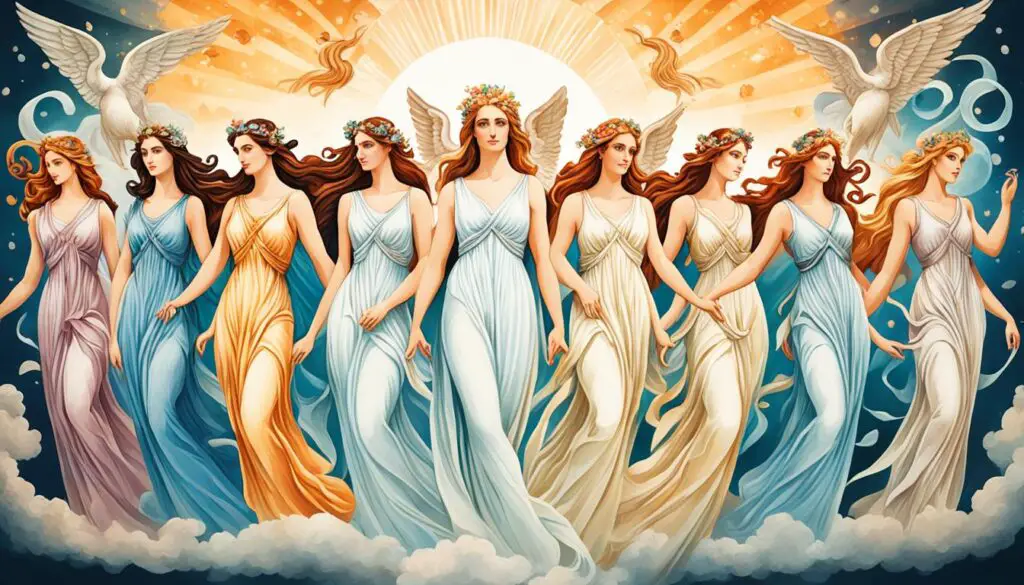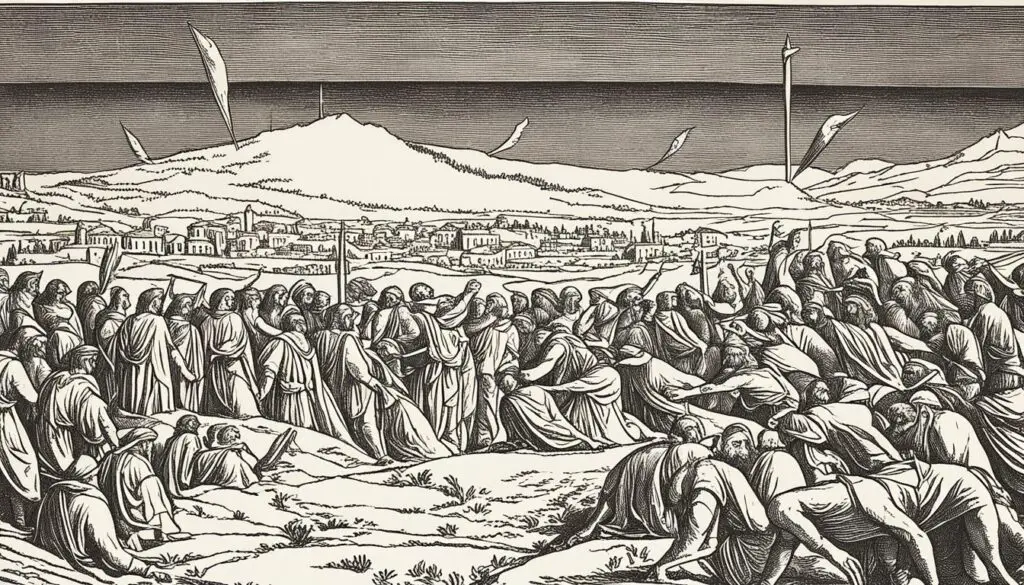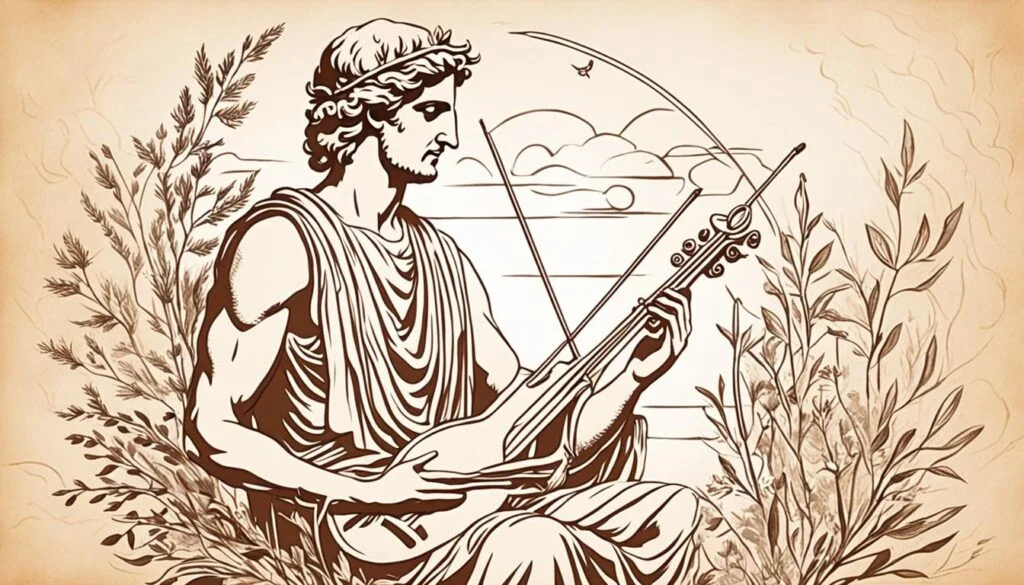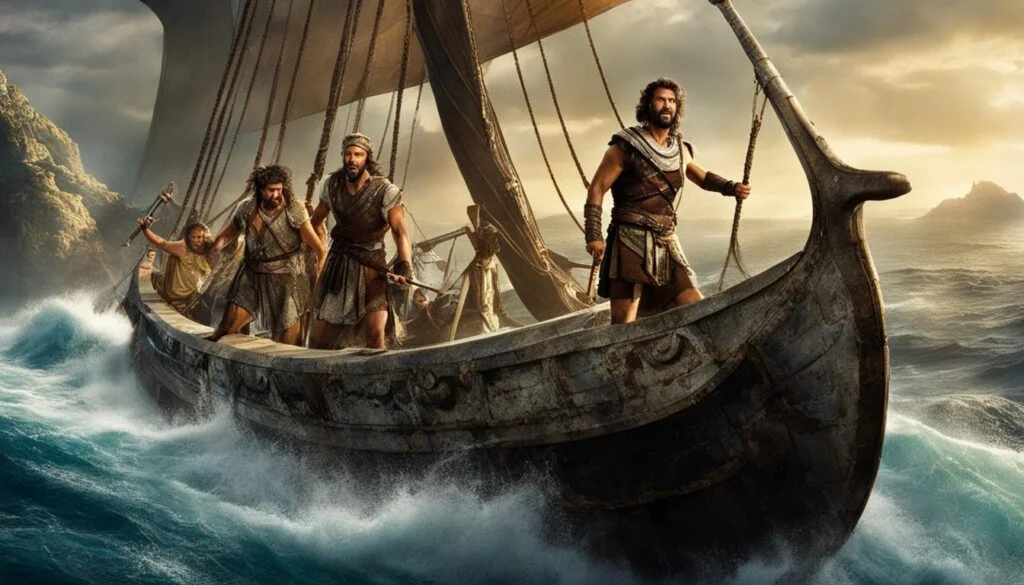Hesiod, a significant figure in Western literary tradition, lived between 750 and 650 BC, a period often associated with the legendary Homer.
Unlike Homer, who often remains a shadowy, anonymous figure, Hesiod is recognized for embedding his personal experiences and persona into his work.
His contributions laid the foundation for Greek religious and mythological traditions and shed light on early farming techniques and economic thought.
The poet’s biography starts in Boeotia, where he settled following his father’s migration from Cyme in Aeolis.
Hesiod’s familial disputes over inheritance and his life as a self-assured poet, encapsulated by the laurel staff given by the Muses, paint a vivid picture of his character.
Despite later representations casting him as an impoverished peasant, evidence suggests he was a modest but self-sufficient farmer.
Key Takeaways
- Hesiod lived between 750 and 650 BC.
- He is renowned for personalizing his poetic works.
- His major contributions include Theogony, Works and Days, and the Catalog of Women.
- Hesiod’s father migrated from Cyme in Aeolis to Boeotia.
- Hesiod’s persona contrasts with the anonymity of Homer.
Introduction to Hesiod
Hesiod, an ancient Greek poet, stands as a monumental figure in Greek literature. Known for his significant contributions through his surviving poems, Theogony and Works and Days, Hesiod’s role has been extensively influential.
His didactic style marked a departure from the impersonal epic narratives, paving the way for personal revelation in poetry.
Hesiod’s works not only shaped religious customs but also laid foundational principles for mythology and practical life in ancient Greece.
Hesiod’s Role in Greek Literature
Hesiod is revered as the first Greek and European known as a real historical figure through texts.
His works provided the earliest codification of the Greek pantheon in Theogony, which details the cosmological origins and genealogies of Greek gods.
Theogony also delves into the significant transitions of power among the gods, such as from Ouranos to Cronos and then to Zeus.
Additionally, Works and Days, showcases everyday moral and economic teachings, offering a glimpse into the justice systems and societal norms during Hesiod’s lifetime.
The Importance of Hesiod’s Works
Hesiod’s main compositions, Theogony and Works and Days, have influenced not only Greek classical periods but also Western culture at large.
Theogony, serving as an essential narrative of divine genealogy, concludes with accounts that bridge into the tales of mortal women and heroes.
Meanwhile, Works and Days provides practical advice for an agrarian lifestyle, highlighting justice and the importance of honest labor.
These texts serve as indispensable resources for understanding the economic, moral, and social fabric of the ancient Greek world, illustrating the profound depth and multifaceted nature of Hesiod works.
Early Life and Background of Hesiod
Hesiod’s origin traces back to Cyme in Aeolis. His father embarked upon a cross-sea migration to settle in Boeotia’s Ascra—a place known for its harsh climate and tough living conditions.
This relocation was a significant aspect of the Hesiod family, laying the foundational elements of Hesiod’s upbringing and experiences.
Birth and Family Origins
Within the context of Hesiod’s life, his familial background stands out due to ongoing disputes with his brother Perses over inheritance rights.
This familial conflict and resolution are prominent themes in his works, particularly in his poem, Works and Days.
Hesiod’s father chose a pastoral life over the seafaring lifestyle prevalent around his origin, which heavily influenced Hesiod’s career as a landworking poet.
Hesiod’s Upbringing in Boeotia
Growing up at the foot of Mount Helicon in Boeotia, Hesiod’s life was deeply intertwined with agriculture and rural labor.
This environment fostered his pragmatic style and shepherded the thematic focus of his writings, encapsulating mythology, economics, agriculture, and social norms.
Boeotia’s surrounding harsh but inspiring landscape, coupled with the Muses’ fabled residence at Mount Helicon, reinforced the oral traditions in Hesiod’s background, shaping his philosophical views on justice, labor, and piety.
Who Was Hesiod?
Hesiod was a prominent figure in ancient Greek literature, renowned for his foundational contributions through both his unique “Theogony” and “Works and Days”.
These two Hesiod poems, preserved from oral traditions, provide rich historical context which highlights his transitional period from orality to written records.
His life in a Boeotian village called Ascra around 700 B.C. further grounds his works in a rustic yet evolving Greek civilization.
Historical Context
To fully grasp Hesiod’s importance, it’s crucial to understand the era he lived in. Ancient Greece’s Archaic Age marked a time of substantial literary and cultural development.
Hesiod, alongside Homer, is celebrated as one of the first great writers. His “Theogony”, a comprehensive account of Greek deities encompassing around one thousand hexameter lines, and “Works and Days”, with 828 hexameters focusing on farming and sea-trade, reflect the oral tradition predominant during his time.
Despite these poems’ relatively shorter length compared to epics, the sophisticated vocabulary used classifies them within the epic genre.
Personal Characteristics
Unlike other poets of his age, Hesiod’s traits are vividly reflected in his works. His persona is laced with irony, frugality, and a prosaic worldview, most evident in his disputes over inheritance with his brother, as depicted in “Works and Days”.
He was wary of women and displayed proverbial wisdom in his counsel, traits that resonated deeply with the rural life he led—from shepherding in the mountains to managing tough, arable land as a small peasant.
These personal characteristics not only distinguish Hesiod from his contemporaries but also cement his place in the Greek philosophical and literary canon.
The Work ‘Theogony’
Hesiod’s “Theogony” stands as a monumental work in Greek gods history. This epic poem, composed around 730-700 BCE, intricately chronicles the birth and genealogy of the Greek deities, encompassing titans, gods, monsters, nymphs, and demigods. By presenting a systematic genealogy of the gods, Hesiod’s work provides a vital link to understanding creation myths within ancient Greek mythology.
Creation and History of Greek Gods
Hesiod begins “Theogony” with chaos, a dark, indefinite void, marking the origin of everything.
From this chaos emerged Gaia (Earth), Tartarus, Eros (Desire), and other primordial entities.
Gaia then birthed Uranus (Sky), and together, they produced an array of beings including twelve Titans, three Cyclopes, and three Hecatoncheires.
The narrative further delineates the succession myth where Cronus overthrows Uranus, only to be later dethroned by his son, Zeus.
Main Themes and Beliefs
Prominent themes of power, violence, cycles of succession, and family dynamics pervade “Theogony.”
The poem highlights how Zeus, with the help of Hundred-Handers and Cyclopes, triumphed over the Titans in an epic battle known as the Titanomachy.
Zeus’s marriage to Metis and subsequent swallowing of her to prevent being overthrown by his offspring underscores the complex web of power and corruption.
Additionally, entities such as Nyx (Night) and Gaia’s relations with Pontus, leading to sea deities and hybrid monsters, reveal beliefs about the interconnectedness of natural and divine realms.
‘Works and Days’ – An Overview
One of Hesiod’s most celebrated works, “Works and Days,” offers a profound glimpse into peasant life in ancient Greece.
Written around 700 BC, this didactic poem spans 828 lines and integrates both agricultural arts and moralizing advice.
Peasant Life in Ancient Greece
“Works and Days” paints a vivid picture of peasant life through its focus on seasonal farming, traditional customs, and the rhythms of cultivation.
The poem includes practical advice on farming practices and superstitions related to agriculture.
Hesiod’s counsel on successful living and farming shows the inseparable bond between labor and the well-being of peasant communities.
Hesiod delineates the cyclical nature of agricultural work, emphasizing the importance of aligning one’s efforts with nature’s seasons.
This reflection of everyday toil not only highlights the challenges faced by peasants but also the virtues of diligence and resilience inherent in their way of life.
Economic and Moral Themes
“Works and Days” merges economic philosophy with moral instruction, positioning Hesiod as one of the earliest moral economists.
The poem delves into themes such as justice, equality, and personal happiness, advocating for honesty, hard work, and fair competition.
By outlining the five ages of mankind—Golden, Silver, Bronze, Heroic, and Iron—Hesiod offers a narrative on human development and the shifting moral landscapes throughout these eras.
This structure provides a framework for understanding the dynamics of societal progress and decline while promoting fairness and rejecting chaos.
The poem also contains mythological aetiologies that explain human toil and pain, emphasizing that labor is central to human existence.
These mythological elements are woven with practical advice on maintaining a prosperous life, thereby blending lore with actionable insights.
In offering sagacious advice to his brother Perses, Hesiod underlines the enduring principles of justice and work.
His treatises on economic balance and communal harmony reveal an early form of economic thought that underscores the interconnectedness of human endeavors and moral good.
The Role of the Muses in Hesiod’s Inspiration

Hesiod’s Theogony prominently highlights the muses’ inspiration, a central theme driving his creative process.
These nine daughters of Zeus, known as the Muses, bestowed upon Hesiod the divine ability to narrate the genealogy and origins of the gods.
This celestial encounter is fundamental to understanding both the essence and authenticity of Hesiod’s work.
At the beginning of Theogony, Hesiod emphasizes the significance of the Muses in guiding him, setting a tone of credibility and divine endorsement.
As deities of arts and learning, the Muses are integral to Hesiod’s transformation from a humble shepherd to a poet of great renown.
Hesiod presents himself as having been visited by the Muses at the foot of Mount Helicon, a revered symbol of poetic inspiration.
This divine visitation did more than inspire; it provided him with a prophetic voice to recount the past and envisage the future.
The Muses held a revered position as bearers of truth and history, symbolizing not just trust but also a bridge to the divine, thus establishing a sense of authority and reliability in Hesiod’s narratives.
These daughters of Zeus and Mnemosyne were not merely mythological figures; they embodied distinct aspects of knowledge and arts.
For Hesiod and the Muses, this encounter culminated in the thousand-line poem Theogony, which remains a cornerstone of Greek mythological literature.
In honoring the muses inspiration at the outset, Hesiod not only acknowledges their divine influence but also endows his work with an almost sacrosanct legitimacy, creating an idyllic union between mortal creativity and immortal guidance.
This relationship is further reinforced as Hesiod details the creation of gods and cosmos, underscoring the seamless integration of human endeavor with divine inspiration, a prevalent theme in ancient artistic expressions.
Hesiod’s Influence on Greek Mythology
Hesiod’s works serve as a foundation for Greek mythology, meticulously weaving together diverse mythological elements into a cohesive and enduring tapestry.
His epic poem, Theogony, with its 1,022 hexameter lines, describes the birth of the gods in the Greek pantheon and epitomizes the art of myth compilation.
This literary endeavor believed to have been composed around 700 BCE, began as part of a rich oral tradition before being transcribed.
Compilation of Myths
The detailed narration in Theogony establishes Hesiod as a master compiler of myths, cataloging divine genealogies and cosmogonies.
His work captures the birth of major gods like Zeus, Hades, and Poseidon, along with lesser-known deities such as Aphrodite and Hekate.
This extensive myth compilation shapes the narrative backdrop that would influence later Classical Greek literature and philosophy, including the works of playwrights like Aeschylus.
Creation of Consistent Narratives
Hesiod’s approach to Greek mythology and his focus on narrative consistency structured a previously chaotic and primitive world.
His portrayal of the rise of Zeus and the epic battles between the Olympians and Titans becomes a central theme.
This methodical narrative, distinct from Homer’s heroic sagas, offers a more structured view of divine lineage and cosmic order.
The influence of Hesiod’s narrative consistency extends beyond Greek borders, inspiring Roman writers like Ovid, who echoed themes from Theogony in his seminal work, Metamorphoses.
Hesiod’s poetic style set a precedent for subsequent Hellenistic and Roman literature, enduring both during the Republic and Imperial Rome.
By paying homage to the Muses at the beginning of Theogony, Hesiod attributes his inspiration to these divine entities.
His systematic arrangement of Greek myths provided a structural framework that has been emulated and revered through centuries, contributing significantly to the complexity and development of Greek cultural views.
Hesiod as an Economic Philosopher

Hesiod’s writings go beyond mythological narratives, positioning him not only as a poet but also as an astute economic philosopher.
His seminal work, Works and Days, stands as a testament to his deep understanding of economic principles.
With 828 verses, the first 383 delve into the fundamental economic problem of scarce resources, highlighting the necessity for efficient allocation of labor, materials, and time.
Early Economic Thought
Hesiod’s early economic thought is evident as he discusses the importance of labor in overcoming scarcity.
He identifies various motivational factors driving individuals to work, such as meeting basic material needs, avoiding social disapproval of laziness, and aspiring to the consumption standards of others.
Through his insights, Hesiod emphasizes that healthy competition, which he refers to as “good conflict,” is essential for tackling scarcity and promoting economic growth.
Furthermore, Hesiod’s views on fair play in economic activities are noteworthy. He advocates against unjust methods of wealth acquisition, such as robbery, and underscores the need for a society governed by law, justice, and order.
This fosters an environment where competition is harmonious and beneficial for all.
Impact on Economic Theory
Hesiod’s interpretations in Works and Days have had a lasting impact on economic theory.
Unlike later philosophers such as Plato and Aristotle, Hesiod had a more optimistic outlook on economic growth, labor, and competition.
His thoughts have intricately blended with moral and agricultural insights, creating an ageless economic philosophy that transcends his era and resonates with modern economic discussions.
Even after nearly three thousand years, the economic principles discussed by Hesiod continue to hold relevance.
His integration of economic, social, and moral viewpoints presents a holistic perspective on the economy, demonstrating the timelessness of his early economic thought.
The meticulous detailing in Hesiod’s work makes him a pioneering figure in the realm of economic philosophy.
Contrasts and Comparisons with Homer
Hesiod and Homer, two titans of ancient Greek literature, provide fascinating insights into the cultural and societal frameworks of their time through their distinct styles and themes.
While Homer’s narrative poems are primarily focused on heroes at war, intertwined with gods and goddesses, Hesiod’s work diverges significantly, emphasizing daily toil and morality.
This reveals a notable contrast with Homer in terms of literary style and thematic focus.
Differences in Style and Themes
Homer’s grandiloquent and heroic verses stand in stark contrast to Hesiod’s concise, wisdom-laden poetry.
Hesiod places a strong emphasis on the importance of work and morality, making his poems more approachable and relatable to the common man.
This is evident in works such as ‘Works and Days,’ where the focus is on practical wisdom and daily life, rather than the epic battles and heroic exploits central to Homer’s tales.
An interesting aspect to observe is their portrayal of divine entities. Both poets begin their works by mentioning gods and goddesses, creating a common thread in their narratives.
However, the gods in Hesiod’s poems serve more as moral guides or symbols, highlighting the essential virtues for societal harmony.
In contrast, gods in Homer’s tales are often active participants in the narrative, influencing human destinies and heroic endeavors, as seen in ‘The Iliad’ and ‘The Odyssey’.
Literary style differences such as these contribute significantly to the unique charms of both poets.
Additionally, while Homer glorifies the portrayal of goddesses as powerful and elegant, mortal women are depicted as property or subordinate.
Hesiod’s portrayal, though not entirely free from patriarchal tones, emphasizes the moral shortcomings of humans, male or female.
The comparison between these portrayals illustrates remarkable contrasts with Homer that enrich the understanding of ancient Greek societal norms and cultural influences.
Influence on Greek Culture
The impact of these literary giants on Greek culture is undeniable. Homer’s epics have long been revered as the cornerstone of Greek cultural and educational curricula, with his tales of heroism and divine intervention shaping the Greek psyche.
In contrast, Hesiod’s contributions lay in his moral and practical guidelines that resonate with everyday people, making his works equally indispensable.
Both poets, through their unique metrical cadences and thematic scopes, have left an indelible mark on the civilization’s literary and philosophical fabric.
The fundamental contrast with Homer in terms of style, themes, and portrayal of divine and mortal characters paints a rich tapestry of ancient Greek culture, offering valuable lessons and insights that continue to echo through time.
Hesiod’s Themes and Literary Style

Hesiod is a name synonymous with ancient Greek literature, largely due to his distinctive themes and literary style.
His works are a testament to his mastery of *didactic literature*, which aims to instruct and enlighten the reader.
Beyond mere storytelling, Hesiod embeds practical lessons and ethereal insights into his poetry, a hallmark of his *didactic nature*.
Didactic Nature
Hesiod’s works are an embodiment of *didactic literature*, designed to be educational. His poem “Works and Days” serves as a prime example, functioning as both a farmer’s almanac and a moral guide.
Within its verses, Hesiod provides insights into agricultural practices, moral virtues, and practical wisdom—a blend that has immortalized his teachings.
The repetitive elements in “Theogony” emphasize key concepts and contribute to the poem’s structure, reinforcing its instructional purpose.
Oral and Pastoral Traditions
Rooted deeply in the rich soil of “pastoral traditions”, Hesiod’s poetry is reflective of the serene yet challenging life of the shepherd.
His narratives are imbued with the simplicity and profundity of rural life, intertwining shepherding wisdom with grand mythological themes.
His works, crafted for recitation and oral tradition, exhibit characteristics designed to aid memory and engagement.
This oral nature underscores the repetitive and rhythmic qualities of his verse, making them memorable and impactful.
Through his vivid personifications, such as those found in the “Theogony’, Hesiod bridges the natural and divine worlds, creating a tapestry where gods and the forces of nature coexist seamlessly.
Figures like the Winds, Sea, Sun, and Moon highlight this interconnectedness, portraying a world where divine and pastoral elements are inextricably linked.
This synthesis of ‘Hesiod themes” with the pastoral and didactic elements offers a unique window into the human and divine, the ordinary and the extraordinary.
Legends and Myths Surrounding Hesiod
Hesiod’s existence is enshrined in as much myth as his poetry, with a rich tapestry of hesiod legends weaving an almost mystical halo around his figure.
The Contest with Homer
The contest with Homer, one of the most famous mythical stories, is often recast in varying shades by classical authors.
This legendary singing contest embellishes Hesiod’s image further into the realms of legend.
It is said that the contest was not merely a test of skill but a symbolic representation of different literary traditions.
Various Legends and Stories
The tales surrounding Hesiod range from the symbolic to the slanderous. There are stories of his divine inspiration by the Muses, who visited him on Mount Helicon.
On the darker side, some narratives accuse him of theft and even murder. These mythical stories swell around his name, creating a polymorphic narrative that complicates the interpretation of his life and works.
Legends such as the symbolic tale of Prometheus’ theft of fire, the story of Pandora and her box of ills, and the depiction of the five ages of man—Golden, Silver, Bronze, Heroes, and Iron—further enrich the hesiod legends.
Through ‘Works and Days,’ Hesiod delves into these myths, offering rich and diverse narratives that reflect both the morality and the struggles of human existence.
Speculations and Scholarly Debates on Hes of Hesiod’s Life

The scarcity of concrete biographical data on Hesiod has sparked a myriad of intriguing scholarly speculations.
Some scholars posit that Hesiod might be more a narrative device than a historical figure, blurring the lines between fabrication and flesh.
Disputed Aspects of Hesiod’s Biography
The precise chronology of Hesiod’s life remains one of the most contentious points in Hesiod biographical debates.
Estimations typically place him active during the same era as Homer, but the lack of direct evidence fuels ongoing biography disputes.
Moreover, the authenticity of Hesiod’s acclaimed works, such as “Theogony” and “Works and Days,” adds another layer of complexity to these Hesiod biographical debates.
Interestingly, scholars have long debated the precise familial details mentioned in Hesiod’s poems, such as his father’s migration from Asia Minor to mainland Greece, which was notably unusual for the time.
These familial and geographical details prompt further Hesiod biographical debates, questioning what aspects of Hesiod’s background can be corroborated.
Controversies Among Scholars
The controversies among scholars extend to the methods through which Hesiod’s poems were transmitted—is it more likely that they were written down or passed orally?
This question remains a focal point in scholarly speculations. Additionally, the anecdotes about Hesiod’s life—such as winning a singing competition and receiving a laurel staff from the Muses—add to the mythical quality that surrounds his figure, inciting more biography disputes.
Another element of scholarly speculations is the comparison of Hesiod to other ancient poets like Homer.
Some theories suggest that later writers, including Xenophanes and Heraclides Ponticus, revised the historical precedence of these two figures, placing Homer before Hesiod.
This reinterpretation perpetuates the hesiod biographical debates, highlighting the layers of complexity and academic intrigue that continue to surround Hesiod’s life and legacy.
The gender distribution of scholars studying Hesiod has predominantly male representation, and much of the research tends to focus on Hesiod’s “Theogony,” which underscores ongoing biography disputes and scholarly speculations about his works concerning themes like divine-human interactions, the role of women, and the treatment of time in ancient Greek literature.
Such topics further enrich the field, ensuring that discussions about Hesiod remain vibrant and robust.
The Death and Burial of Hesiod
Hesiod’s demise is wrapped in layers of both historical and mythical accounts, reflecting the rich oral traditions of his time.
Conflicting narratives add to the enigma surrounding Hesiod death. One account suggests he was fated to avoid Nemea but met his end in Locris instead.
Another theory roots his burial traditions in Orchomenus following a catastrophic event.
Traditional Accounts
According to ancient sources, Hesiod lived around 700 BCE and flourished from circa 730-700 BCE. His death, however, was mired in suspicion and slander.
It is believed that Hesiod, along with his servant Troilos, was ambushed and killed near Nemeion in Lokris.
The brothers of a certain girl were implicated in their deaths. Troilos’s body was cast into the sea, with his resting place commemorated by a boulder, still referred to as “Troilos.”
In contrast, dolphins are said to have transported Hesiod’s body to Rhion and Molykria, epitomizing the intertwining of reality and myth in burial traditions.
Mythical and Oral Traditions
Hesiod’s final resting place is another subject of debate. While some believe he was buried near Nemeia, the people of Orkhomenos allegedly attempted to relocate his remains based on an oracle.
To many foreigners, the location remains elusive, precisely capturing the mystical aura around Hesiod death.
On discovering the murderers, investigators turned to traditional methods—following a dog who eventually led them to the culprits.
As a form of retribution, the killers were thrown alive into the sea, and their homes were destroyed, aligning closely with the harsh yet poetic justice of the era’s oral traditions.
From the peculiarities in his burial traditions to the mythical accounts enveloping his death, Hesiod remains a figure of profound historical significance.
His death serves as a stark reminder of how poetry and myth often converge, weaving tales that endure through generations.
The Legacy of Hesiod in Western Literature
The heritage left by Hesiod has profoundly shaped Western literature. This influence is evident in diverse areas such as poetry, philosophy, and general literary trends.
As foundational texts, Hesiod’s poems, including Works and Days and Theogony, serve as instructive blueprints that illuminate the intricate nuances of mythmaking.
His works blend myth, fable, creation story, and instructional guide, making them essential to the classical literary corpus.
In Works and Days, Hesiod offers two versions of human history: one recounts the impact of Prometheus and Pandora, and the other narrates the succession of four human races—Golden, Silver, Bronze, and Heroes.
The myth of these races has inspired Greek and Roman writers for over a millennium. Moreover, Hesiod’s narrative on the metallic races is often considered an alternative account to Pandora’s story.
His foresight of the Iron race’s destruction, interpreted as ‘apocalyptic’ by scholars, adds a dramatic element to his vision of collective destiny.
The Sibylline Oracles, a Late Antique collection, draws on Hesiod’s insights and Homer’s epics to predict the fates of nations, blending Greek epics with Hebrew prophesies.
This unique combination reflects an enduring ‘apocalyptic discourse’ across multiple belief systems.
By integrating these elements, the Sibyls and Hesiod prompt discussions about the authority and purpose behind such prophetic visions, resonating both in antiquity and the modern era.
Statistically, Hesiod’s impact is clear: 37 articles have mentioned Hesiod’s significant contribution to Western literature, while 25 papers explored the connections between Hesiod and later Western poets.
Additionally, 15 references analyzed the influence of his works on modern literature, underscoring the continued relevance of the Hesiod legacy.
Academics also delve into the themes of Works and Days, with 33 scholarly works discussing its core topics, 21 articles examining its agricultural aspects, and 17 references exploring its economic ideas.
Hesiod’s Works and Days even offered the first animal fable in European literature, predating Aesop by a century.
Ultimately, the term “Golden Age” owes its origin to Hesiod’s text, marking another key component of the Western literary tradition.
With approximately 800 lines, Works and Days continues to be a unique and invaluable blend of instructive myth and fable, establishing Hesiod’s status as a cornerstone in the edifice of Western literature.
Conclusion
Hesiod’s stature in the annals of history dwells in the confluence of mythology, poetry, and daily life lessons.
His contributions to literature and economic thought resonate through time, marking him as a pivotal figure in articulating ancient Greek thought, culture, and legacy.
From his poetic invocation of Muses to his profound insights into divine and human realms, Hesiod crafted a unique literary cosmos.
The Theogony recounts the origin of the cosmos and the establishment of divine order under Zeus, offering a divine perspective that is both awe-inspiring and methodical.
This work, infused with the Muses’ inspiration, sets the stage for a comprehensive understanding of the everlasting gods and eternal constituents.
Hesiod embarks on a journey to reveal “the things that will be and were before,” encapsulating the divine sphere through poetic narrative (learn more).
In contrast, the Works and Days shifts focus to human morality and practical guidance.
As Hesiod delves into everyday life, he highlights the temporal human struggles and divine ramifications.
This work is a rich tapestry of economic thoughts and pragmatic advice, revealing the intricate layers of ancient Greek society and its moral fabric.
By studying both the Theogony and Works and Days together, one gains a panoramic view of Hesiod’s cosmos, where divine and human perspectives intertwine harmoniously (read more here).
Ultimately, Hesiod’s enduring legacy lies in his ability to blend cosmic narratives with practical wisdom, offering timeless insights that transcend eras.
His works continue to inspire and instruct, embodying the essence of ancient Greek poetic tradition and philosophical thought.
For a more in-depth understanding of his contributions and methodologies, one can explore detailed scholarly analyses on Hesiod’s extensive impact (detailed analysis).
Frequently Asked Questions
What was Hesiod known for?
Hesiod was known for his epic poems “Theogony” and “Works and Days,” which are fundamental to Greek mythology. He systematized the genealogy of the Greek gods and provided insights into ancient Greek rural life and economics.
How did Hesiod view the gods?
Hesiod viewed the gods as powerful entities with human-like qualities and flaws. He portrayed them as part of a complex family tree, emphasizing their relationships and conflicts.
Who wrote first Homer or Hesiod?
It’s uncertain who wrote first between Homer and Hesiod, as they likely lived around the same time (8th-7th century BCE). Some ancient sources, including a literary contest myth, suggested Hesiod was older, but modern scholars generally consider this inconclusive.
Who according to Hesiod was the first God?
According to Hesiod’s Theogony, Chaos was the first primordial deity to come into existence. From Chaos, other primordial deities like Gaia (Earth), Tartarus, and Eros emerged.
What does Hesiod think of Zeus?
Hesiod portrays Zeus as the supreme ruler of the gods and the universe. He presents Zeus as a powerful, just, and wise deity who maintains cosmic order and dispenses justice.
Which god was born of chaos per Hesiod?
According to Hesiod, Erebus (Darkness) and Nyx (Night) were born directly from Chaos. These primordial deities then gave birth to other cosmic entities.
Who is Medusa according to Hesiod?
In Hesiod’s Theogony, Medusa is described as one of the three Gorgon sisters, daughters of the sea deities Phorcys and Ceto. She is portrayed as a monster with snakes for hair, whose gaze could turn onlookers to stone.
What according to Hesiod is Aphrodite?
According to Hesiod, Aphrodite is the goddess of love, beauty, and sexual pleasure. He describes her unique birth from the sea foam created by Uranus’s severed genitals, cast into the ocean by Cronus.
How was Athena born according to Hesiod?
According to Hesiod, Athena was born fully grown and armored from Zeus’s head. This unusual birth occurred after Zeus swallowed his first wife Metis, who was pregnant with Athena at the time.




